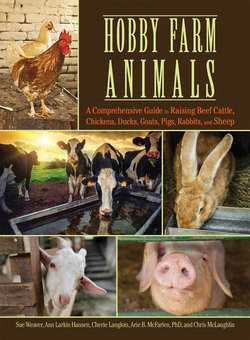Читать книгу Hobby Farm Animals - Chris McLaughlin - Страница 46
На сайте Литреса книга снята с продажи.
Heritage Breeds
ОглавлениеFortunately, growing legions of poultry fanciers and small-scale chicken raisers are stepping forth to reclaim our forebears’ poultry breeds. This rare-breed renaissance is occurring throughout the world for numerous reasons.
Some conservators long for the mouthwatering fried chicken Grandma used to serve for Sunday dinner or for yummy, orange-yolked eggs with divine flavor. Some yearn to preserve living remnants of our distant past. Others do it in the name of biodiversity—they feel that if disease or genetic malady should strike down America’s beleaguered battery hens and broilers, there must be hardy Heritage breeds ready to take up the slack. Some simply prefer breeds created for specific environments and needs, such as Buckeyes and Hollands for free-range eggs, Chanteclers for winter laying in the far North, or heat-tolerant Cubalayas for the steamy South.
Before you join the rare-breed contingent, get to know The Livestock Conservancy (formerly the American Livestock Breeds Conservancy). This is a nonprofit membership organization devoted to the promotion and protection of more than 150 breeds of livestock and poultry. In service since 1977, it’s the primary organization in the United States working to conserve rare breeds and genetic diversity in Heritage livestock. In 2009, The Livestock Conservancy launched its Heritage-chicken promotion, and it’s eager to provide new Heritage-breed producers, large and small, with materials to help get started and, later, to promote and market eggs and meat from their Heritage chickens.
Endangered Breeds
If you join The Livestock Conservancy, you’ll receive the organization’s bimonthly print newsletter and an annual directory full of contacts. Livestock Conservancy breeders make up an active network of people who participate in hands-on conservation, marketing, and public education; if you are getting into chicken keeping, particularly if you plan on raising, showing, or breeding endangered breeds, they are definitely people you want to know.
To find out which chicken breeds meet Heritage-breed requirements, visit The Livestock Conservancy’s website (www.livestockconservancy.org) and click on “Heritage Breeds,” then “Poultry Breeds,” and then “List of Chicken Breeds.” This will bring you to the Conservation Priority List (CPL) for chickens, where breeds are categorized according to the following criteria as defined by The Livestock Conservancy.
Critical: “Fewer than 500 breeding birds in the United States, with 5 or fewer primary breeding flocks (50 birds or more), and estimated global population less than 1,000.” Breeds in the Critical category in 2015 were the Campine, Chantecler, Crevecoeur, Holland, Modern Game, Nankin, Redcap, Russian Orloff, Spanish, Sultan, Sumatra, and Yokohama.
Threatened: “Fewer than 1,000 breeding birds in the United States, with 7 or fewer primary breeding flocks, and estimated global population less than 5,000.” Breeds in the Threatened category in 2015 were the Andalusian, Buckeye, Buttercup, Cubalaya, Delaware, Dorking, Faverolles, Java, Lakenvelder, Langshan, Malay, and Phoenix.
Watch: “Fewer than 5,000 breeding birds in the United States, with 10 or fewer primary breeding flocks, and estimated global population less than 10,000. Also included are breeds with genetic or numerical concerns or limited geographic distribution.” Breeds in the Watch category in 2015 were the Ancona, Aseel, Brahma, Catalana, Cochin, Cornish, Dominique, Hamburg, Houdan, Jersey Giant, La Fleche, Minorca, New Hampshire, Old English Game, Polish, Rhode Island White, Sebright, and Shamo.
Recovering: “Breeds that were once listed in another category and have exceeded Watch category numbers but are still in need of monitoring.” Breeds in the Recovering category in 2015 were the Australorp, nonindustrial Leghorn, Orpington, Plymouth Rock, nonindustrial Rhode Island Red, Sussex, and Wyandotte.
Study: “Breeds that are of interest but either lack definition or lack genetic or historical documentation.” Breeds in the Study category in 2015 were the Araucana, Icelandic, Manx Rumpy (or Persian Rumpless), and Saipan.
| What Is a Heritage Breed? In order to support the American Poultry Association (APA) in bringing the Heritage breeds back to popularity, The Livestock Conservancy has created a list of criteria that chickens must meet to be called Heritage. The following is the definition set forth by The Livestock Conservancy. Heritage chicken must adhere to all of the following conditions. 1.APA Standard Breed. Heritage chicken must be from parent and grandparent stock of breeds recognized by the APA prior to the mid-twentieth century, whose genetic line can be traced back multiple generations, and with traits that meet the APA Standard of Perfection guidelines for the breed. Heritage chicken must be produced and sired by an APA Standard breed. Heritage eggs must be laid by an APA Standard breed. 2.Naturally mating. Heritage chicken must be reproduced and genetically maintained through natural mating. Chickens marketed as Heritage must be the result of naturally mating pairs of both grandparent and parent stock. 3.Long, productive outdoor lifespan. Heritage chicken must have the genetic ability to live a long, vigorous life and thrive in the rigors of pasture-based, outdoor production systems. Breeding hens should be productive for five to seven years and roosters for three to five years. 4.Slow growth rate. Heritage chicken must have a moderate to slow rate of growth, reaching appropriate market weight for the breed in no less than sixteen weeks. This gives the chicken time to develop strong skeletal structure and healthy organs prior to building muscle mass. |
